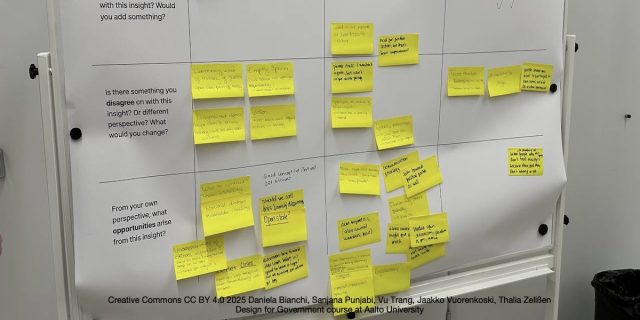This blog post reports on work-in-progress within the DfG course! The post is written by group 1 dealing with the Ministry of Finance’s brief on ‘Open Governance’. The group includes Vu Trang from the Sustainable Entrepreneurship program (Aalto BIZ), Sanjana Punjabi from the Collaborative and Industrial Design program (Aalto ARTS), Daniela Bianchi from Collaborative and Industrial Design program (Aalto ARTS), Thalia Zelißen from the Environmental Engineering Program (TU Munich) and Jaakko Vuorenkoski from Information and Service Management program (Aalto BIZ).
Written by: Jaakko Vuorenkoski
For the past twelve weeks, we’ve immersed ourselves in the landscape of participation and open democracy in Finland. We started by reimagining Open Government Finland as an orchestrator of “action coherence”then reimagined it as a peer-to-peer working concept—and now, it’s time for our final proposal: Building Democratic Resilience.
From Interviews to Insights
Since our last blog post, we finished our final interviews. These gave us lots of valuable insights, which helped us refine our thinking and develop our final proposal. We also had a productive co-creation session with our partners, which helped us get new perspective for insights we had gathered, and got some new ideas for avenues to pursue. To facilitate the dicussion regarding our insights, we had a chart to guide the feedback regarding our analysis during the co-craetion session. This helped us have a better picture of which insights resonated with our partners, what they agreed with and what they had suggestions or improvements for.
Now, after all our research, it was time to start preparing for the finale of the whole course, and coming up with a final proposal to our partners. Amid the flood of ideas and us being full of excitement, we quickly became overwhelmed with bunch of different proposals. However, in our many working sessions together, and with the help of our guiding professors, we realized we needed to focus. It was time to sharpen our analysis, and unite around a clear, compelling narrative.

Figure 1. Co-creation session: Feedback on insights
The Falling Trust
In the media, much of the blame for the global democracy crisis is placed on citizens: they aren’t informed enough, they don’t care, they spend too much time on social media—classic symptoms of Meadows’s (2019) “Shifting the Burden to the Intervenor” trap. But I don’t believe these diagnoses get to the heart of the issue. So, to get to our final proposal, we decided to take a step back, and analyze together the true problem of public trust in government. In our minds, the Open Government principles, when truly being put to practice throughout the nation, would help Finland immensely, towards a healthier democracy. We also agreed that Open Government Finland is uniquely positioned to step up as the torchbearer of this. By leveraging its existing civil-society network, it can reconnect policy-makers and everyday people, forging a new bedrock of mutual confidence.
From this, and by connecting our thoughts to the evidence we had collected, we constructed main opportunities:
- Open Government as a Direct Link between Policy-Makers and People
Open Government Finland has already successfully gathered together an active civil-society network: associations share best practices, test new digital participation tools, and fuel grassroots innovation. Now it’s time to shift the focus to building a strong network at the policy level too. Bridging the gap between people and policymakers is key to strengthening trust and cooperation. This way citizens’ voices could travel faster, policy-makers could receive richer insights, and both sides would build trust through repeated exchanges. Like
- Open Government as an Advocate for Its Principles at the Policy Level
From our interviews, we found that the Open Government’s nine core principles resonate deeply, yet, their adoption at the policy evel remains faint. To cement these ideals into the very DNA of government, we propose turning Open Government into a policy advocate. By giving Open Government the tools and formal mandates to advocate inside political arenas, we ensure these principles move beyond goodwill statements and become non-negotiable benchmarks for all branches of government.
Towards the Finale
Over the past week, we’ve refined our proposal’s structure, shifting from a fragmented collection of ideas into a cohesive vision that clearly captures our insights. Yet as we approach the finale, I’m equal parts excited and nervous:
– What will our partners think? Will they see the same promise in these proposals that we do?
– How can we articulate our thoughts clearly and consistently throughout our final report?
– How will I feel after all this is over? It has been both intense, and extremely rewarding, so what will be the key lessons, that I’ll carry with me
Regardless of the outcome, when I reflect on our journey—both my own growth and our team’s collective progress—I feel immensely proud of how far we’ve come.
Next, we will present our proposals at city hall, and finalize a written report. Stay tuned!
References
Meadows, D. H. (1999). Leverage points: Places to intervene in a system. https://donellameadows.org/
The DfG course runs for 14 weeks each spring – the 2025 course has now started and runs from 24th Feb to 27th May. It’s an advanced studio course in which students work in multidisciplinary teams to address project briefs commissioned by governmental ministries in Finland. The course proceeds through the spring as a series of teaching modules in which various research and design methods are applied to address the project briefs. Blog posts are written by student groups, in which they share news, experiences and insights from within the course activities and their project development. More information here about the DfG 2025 project briefs.

